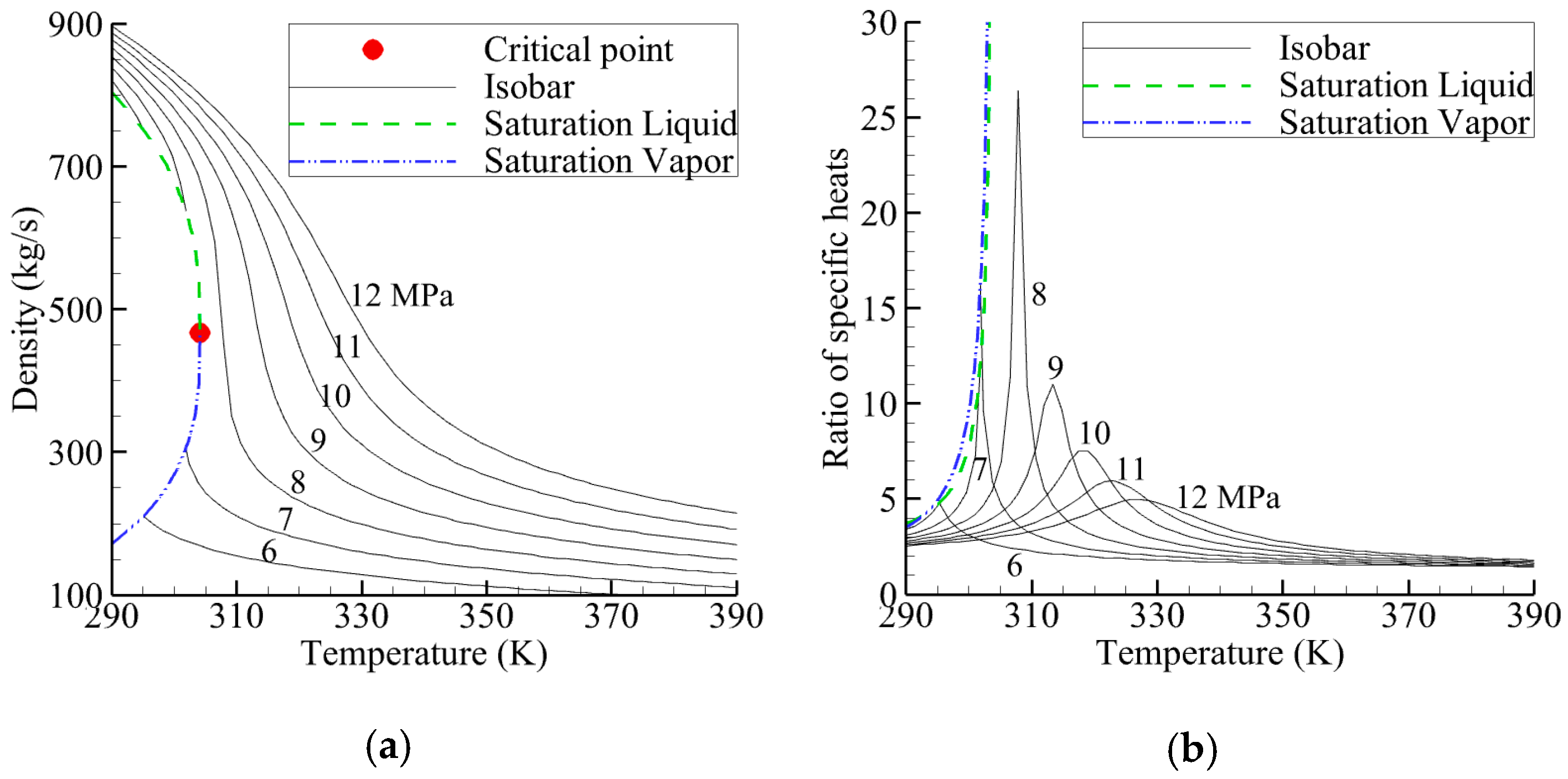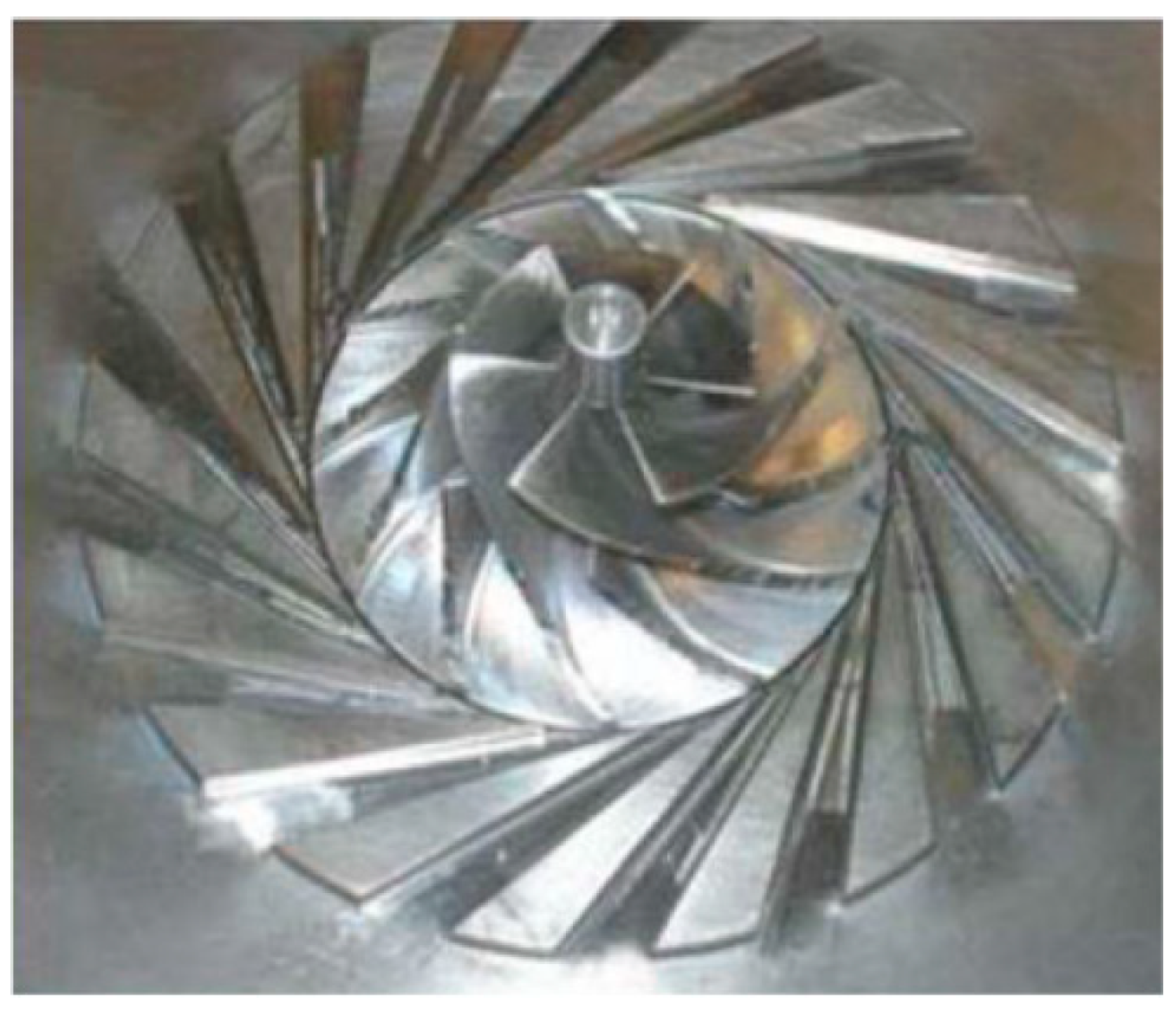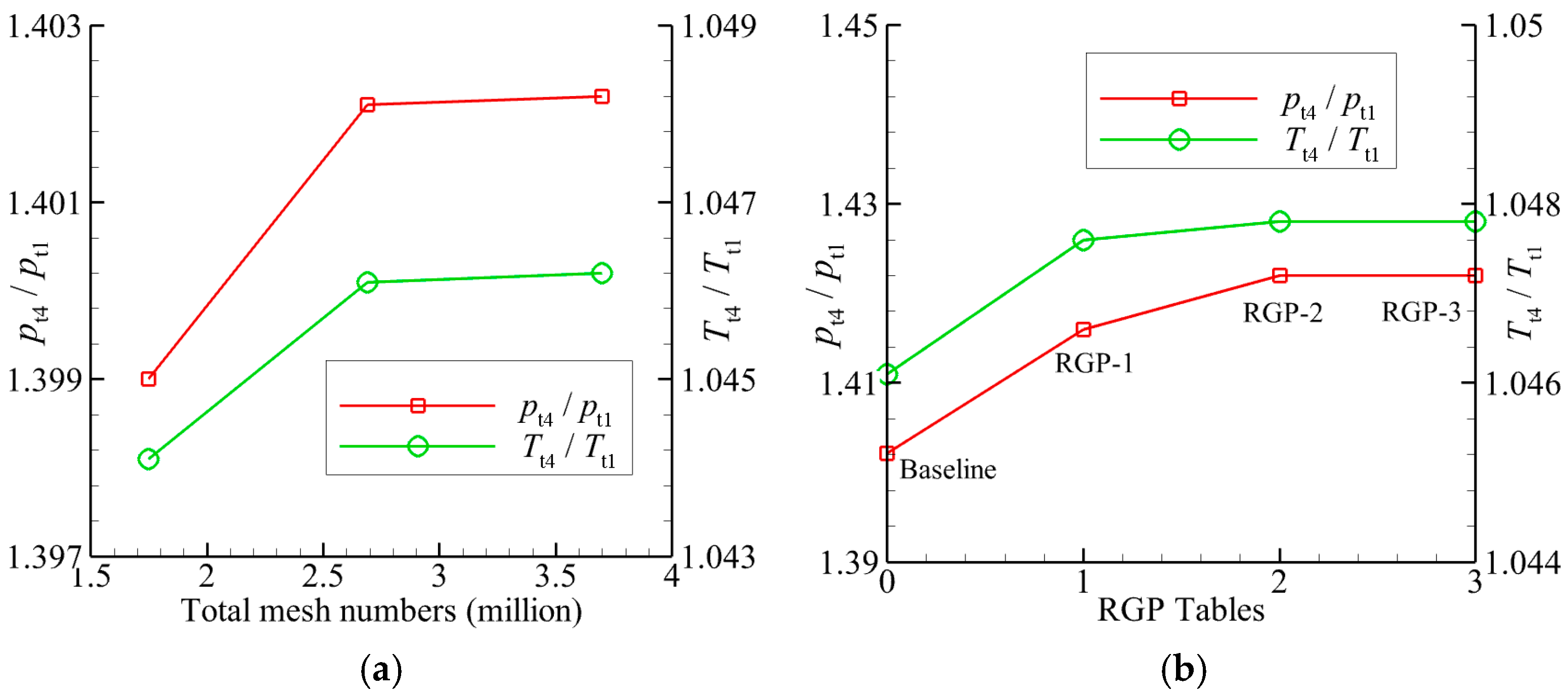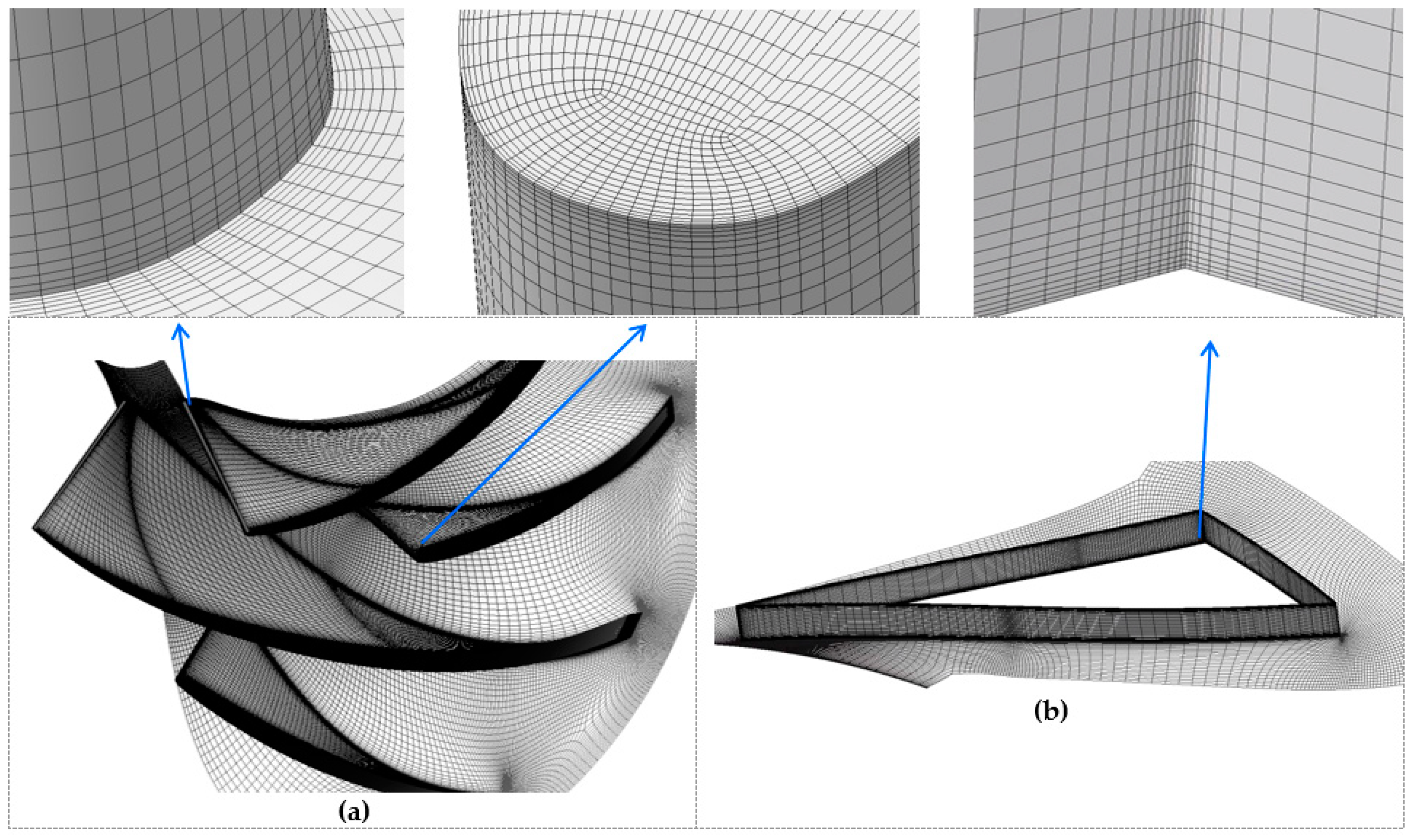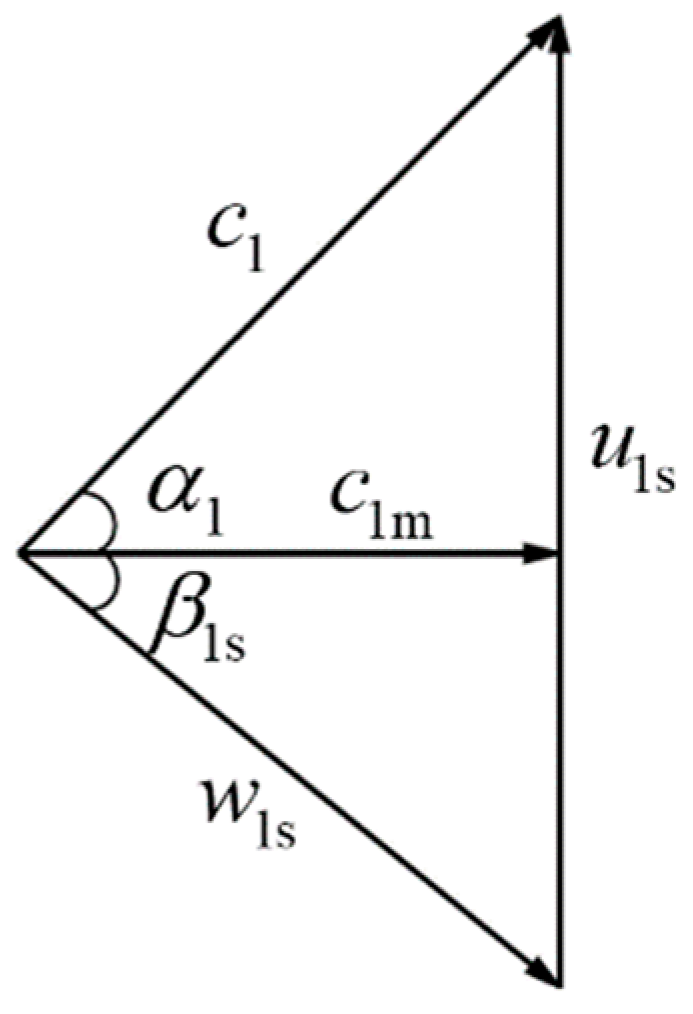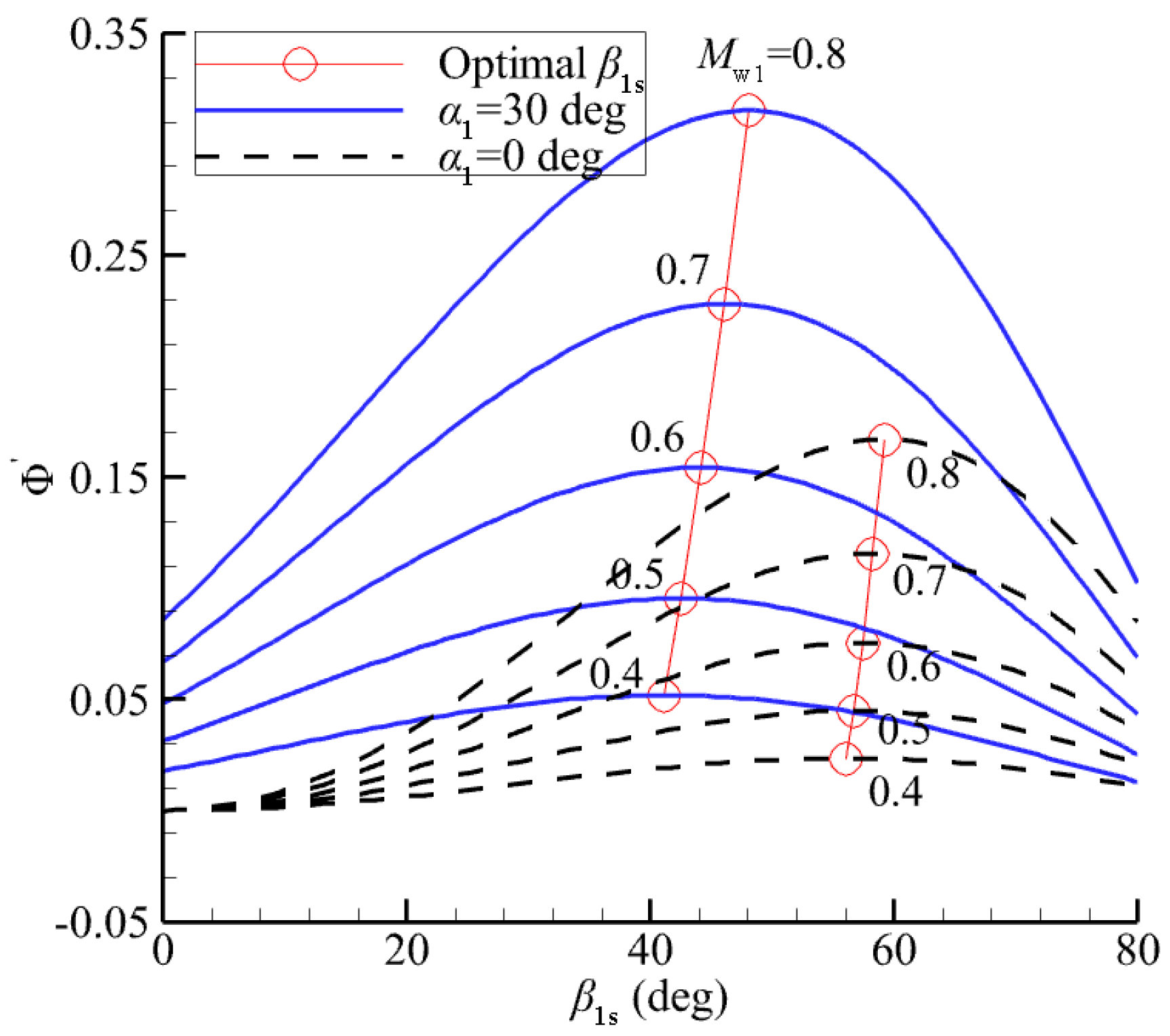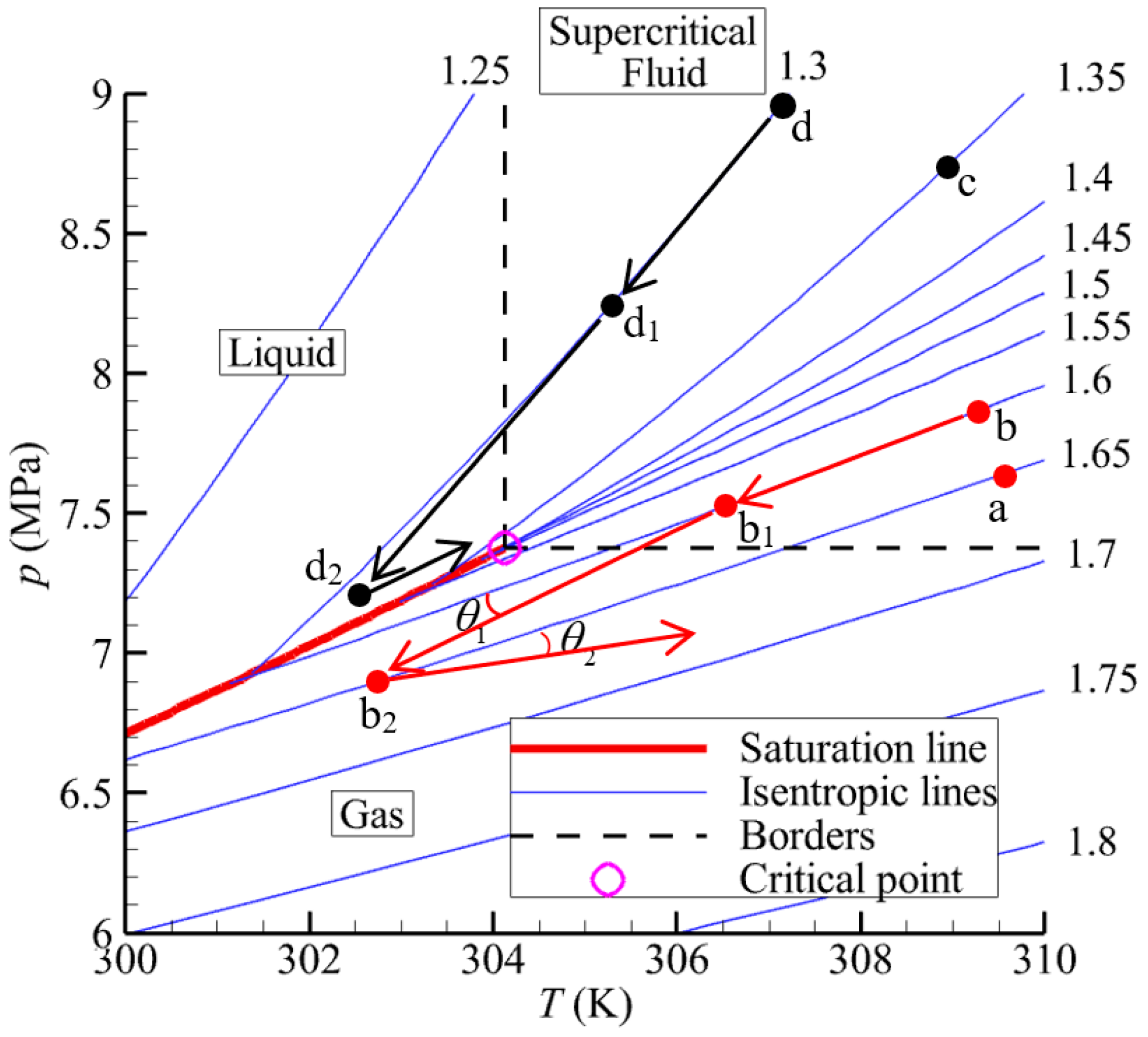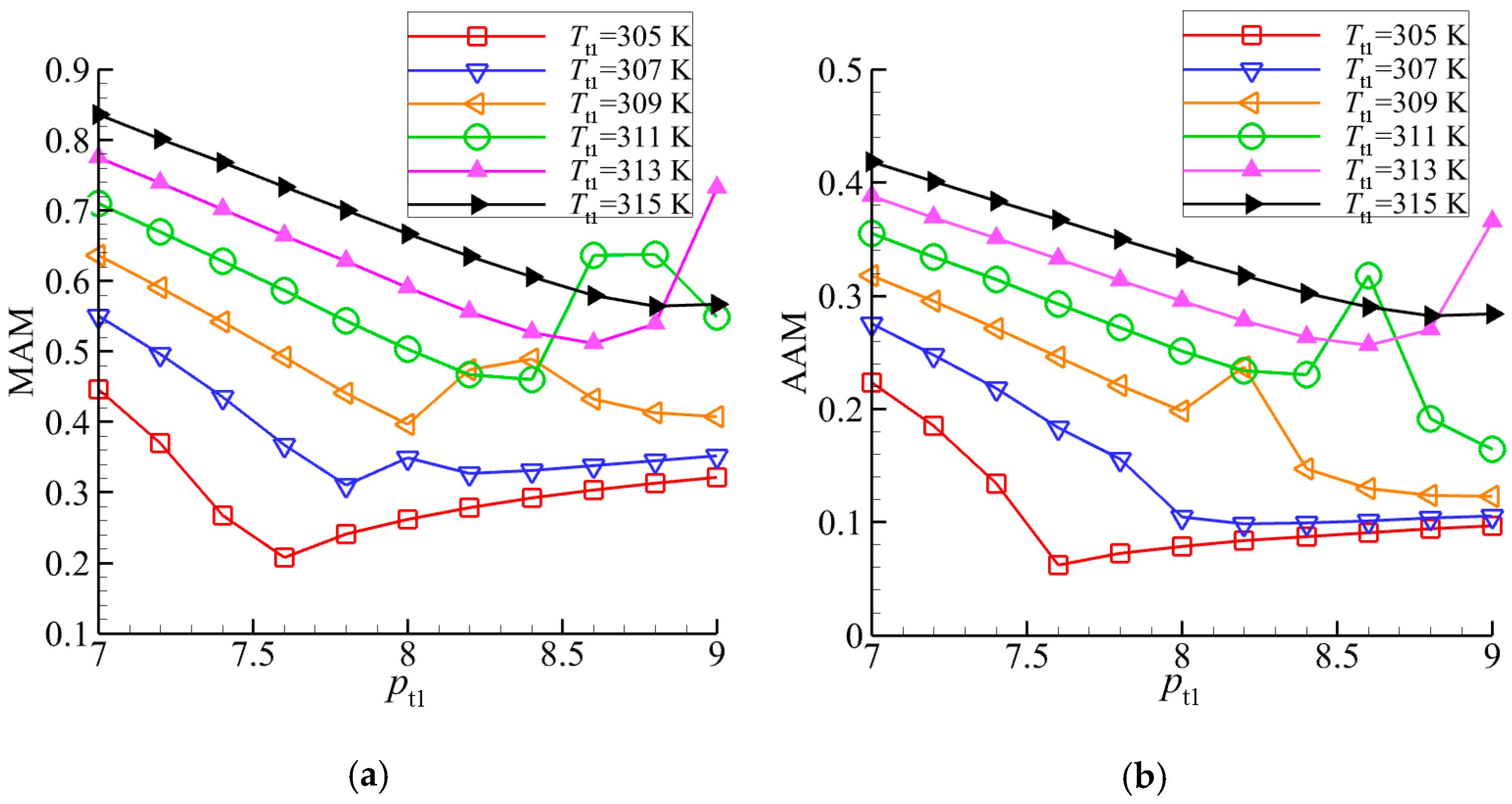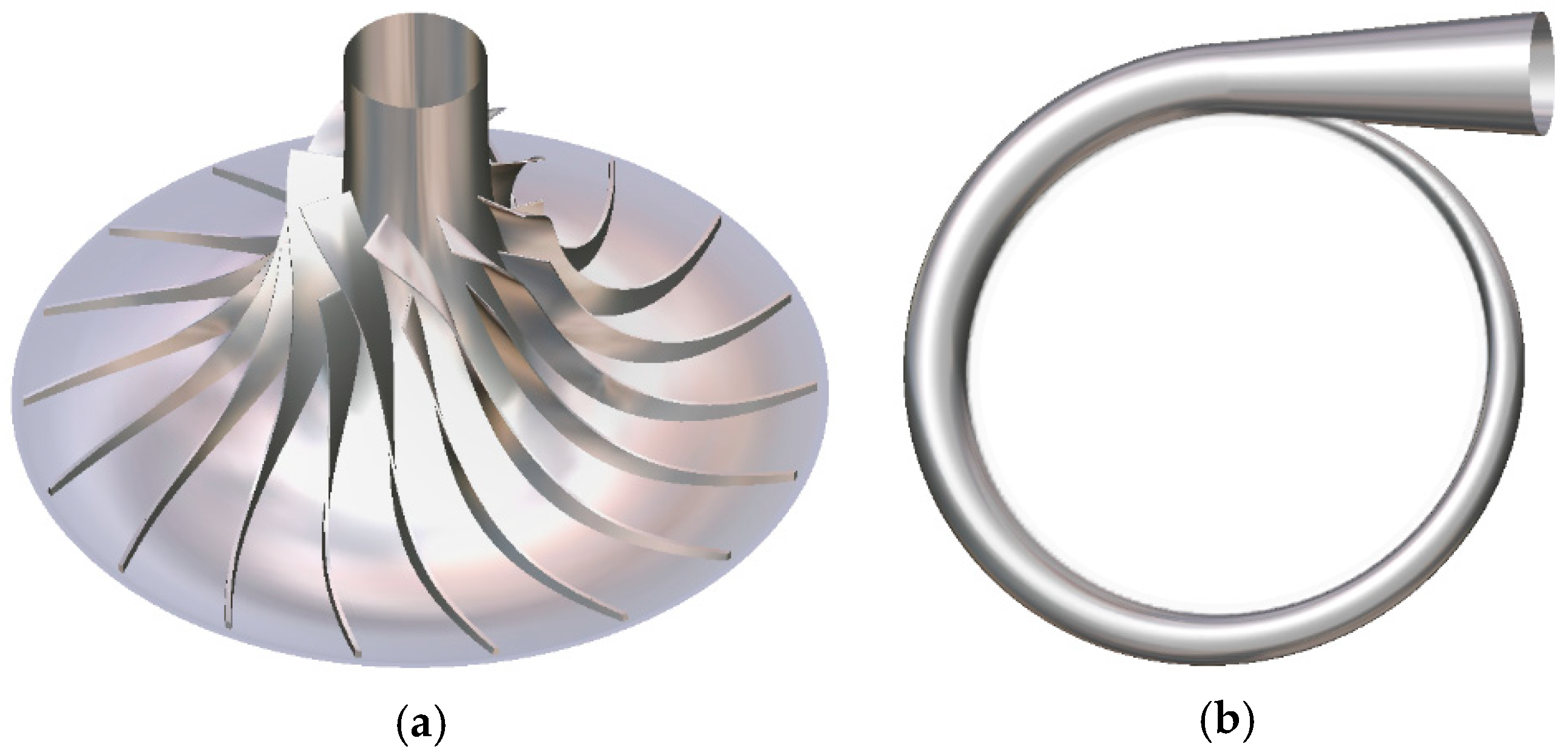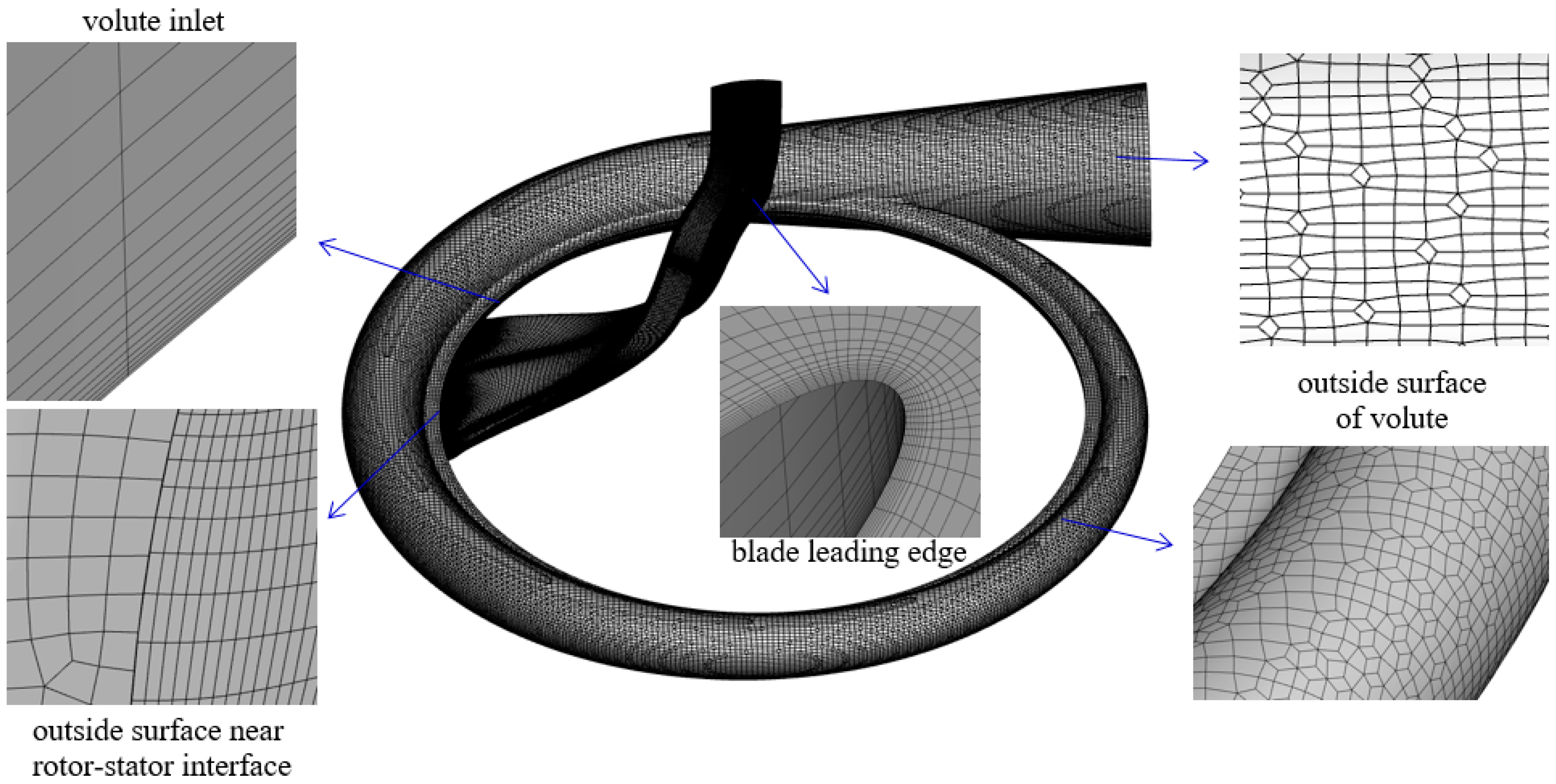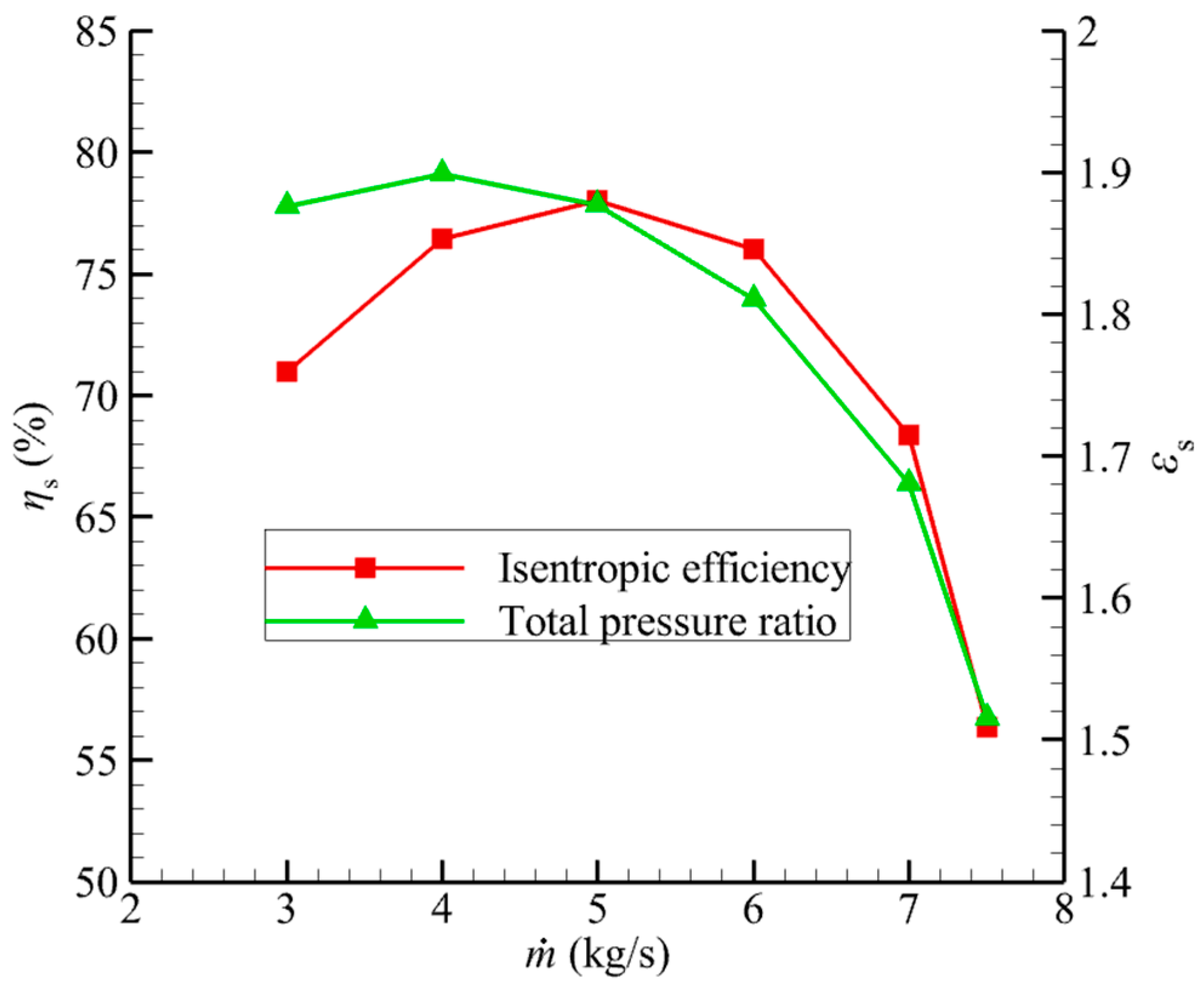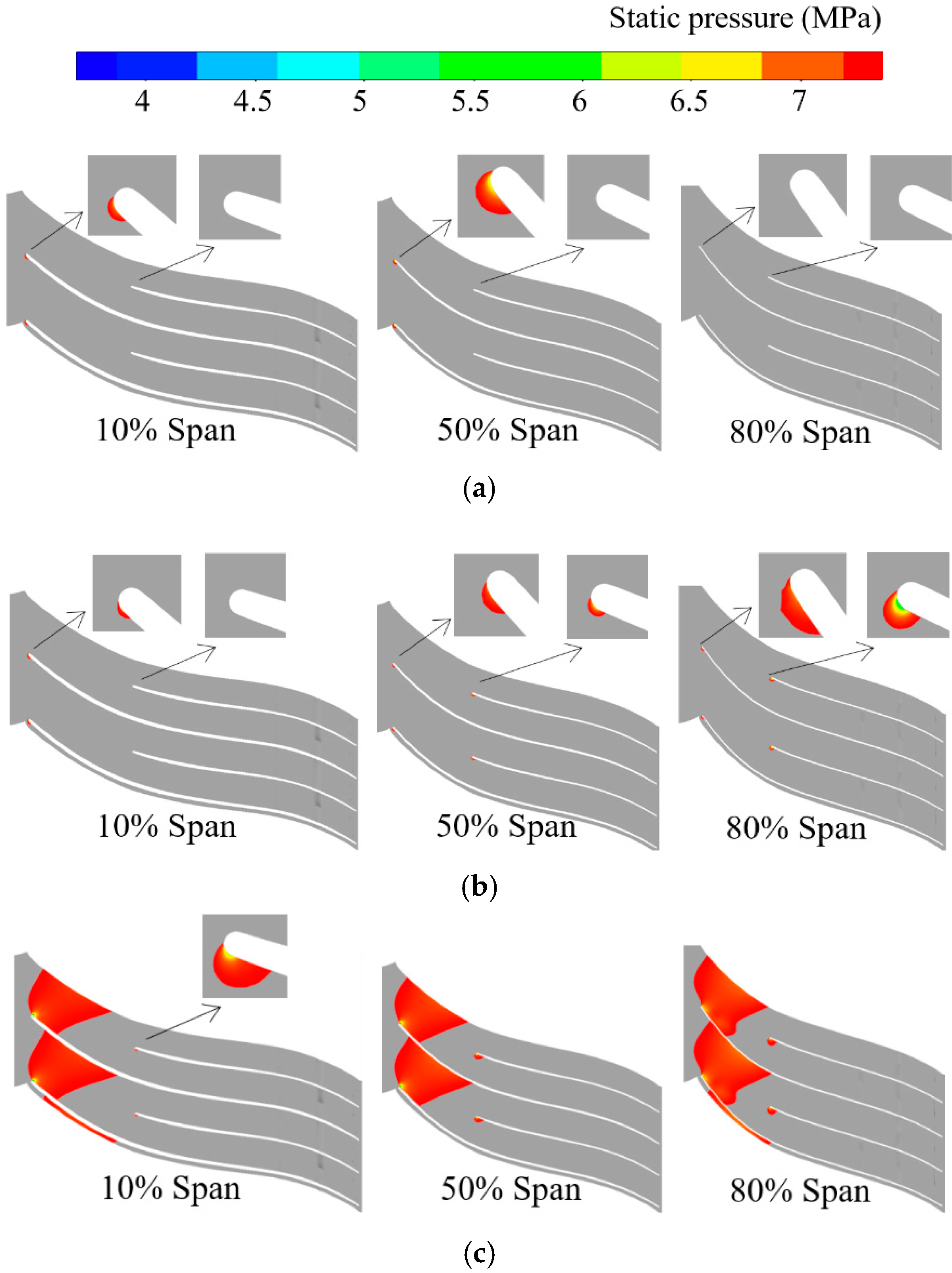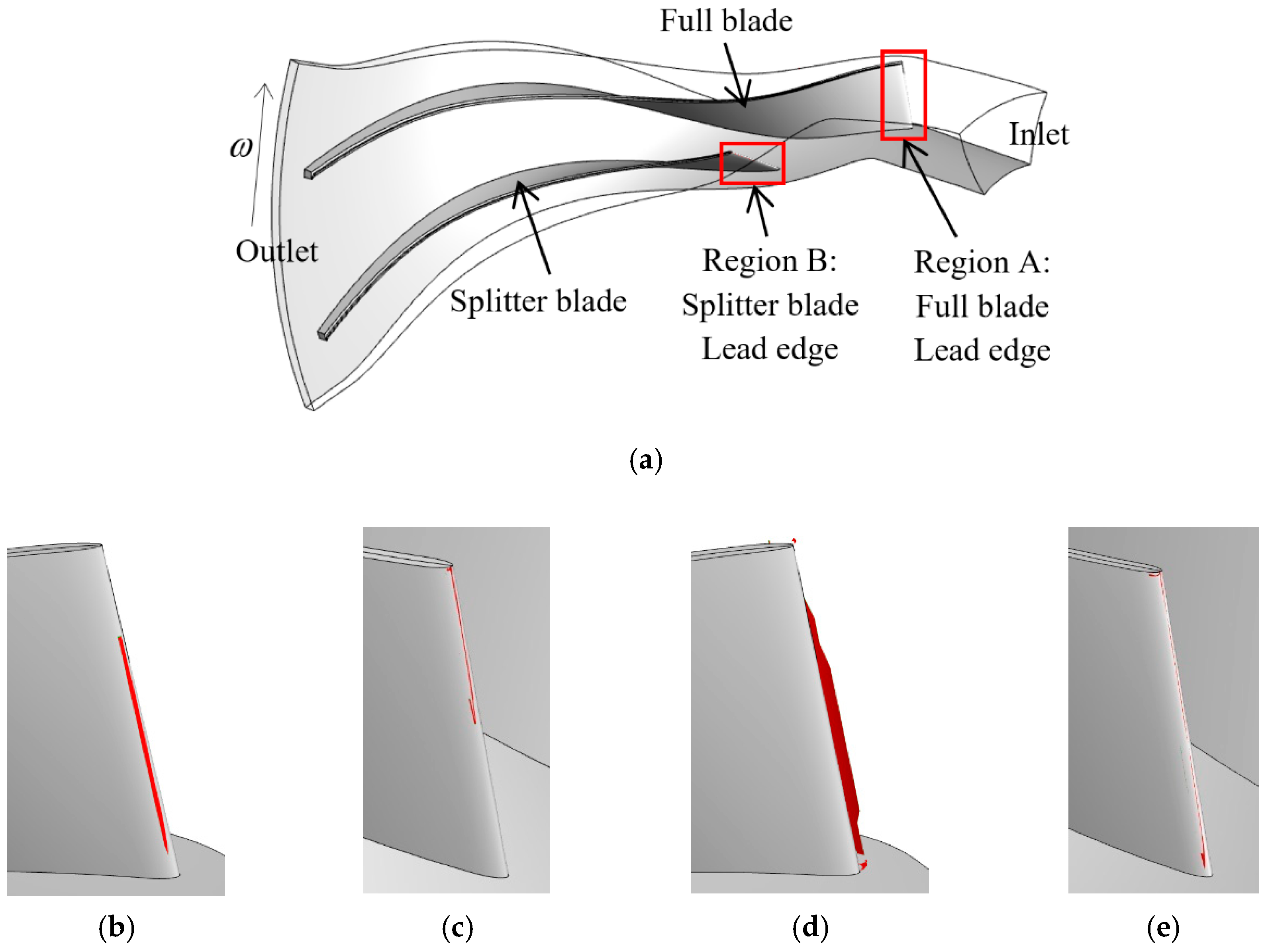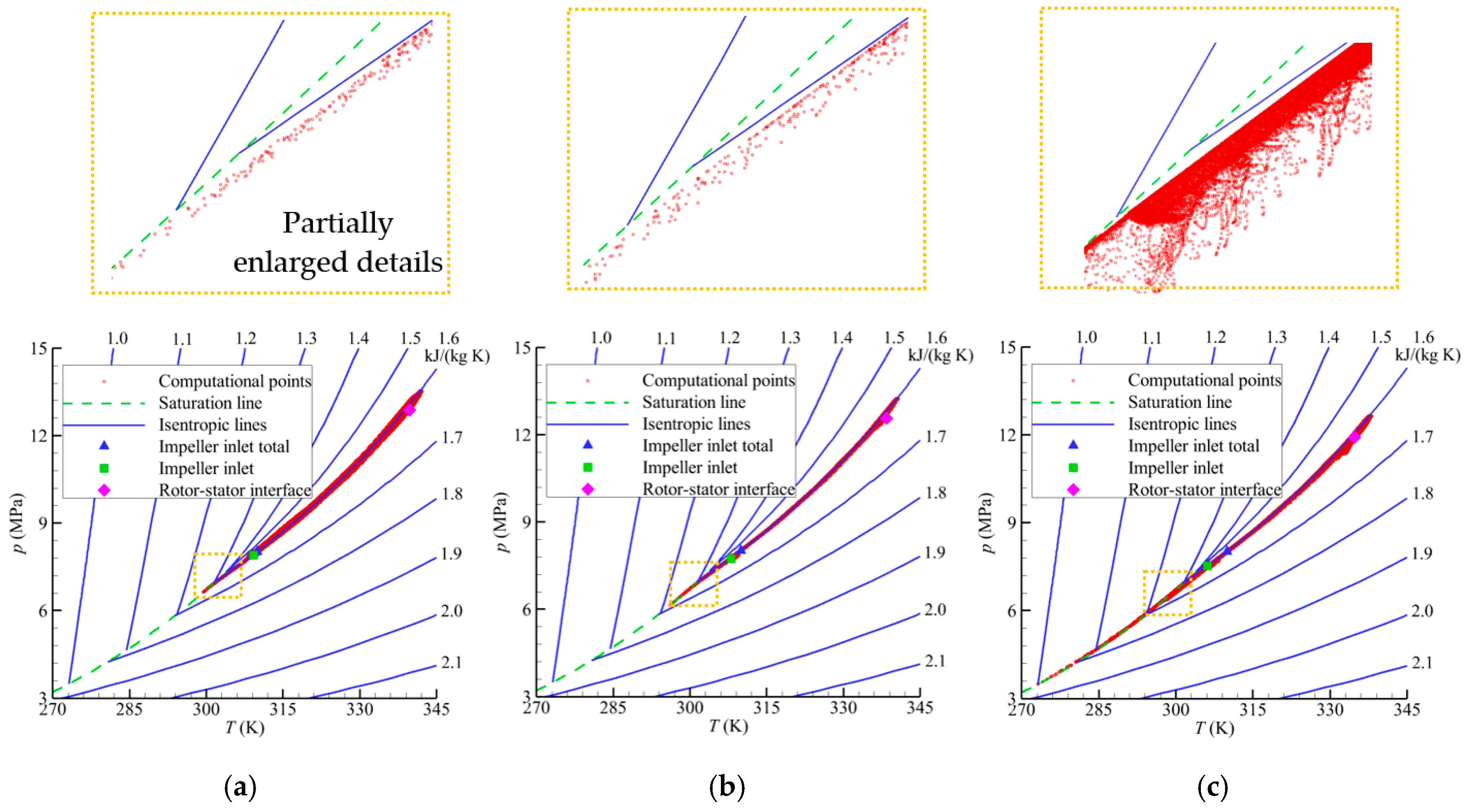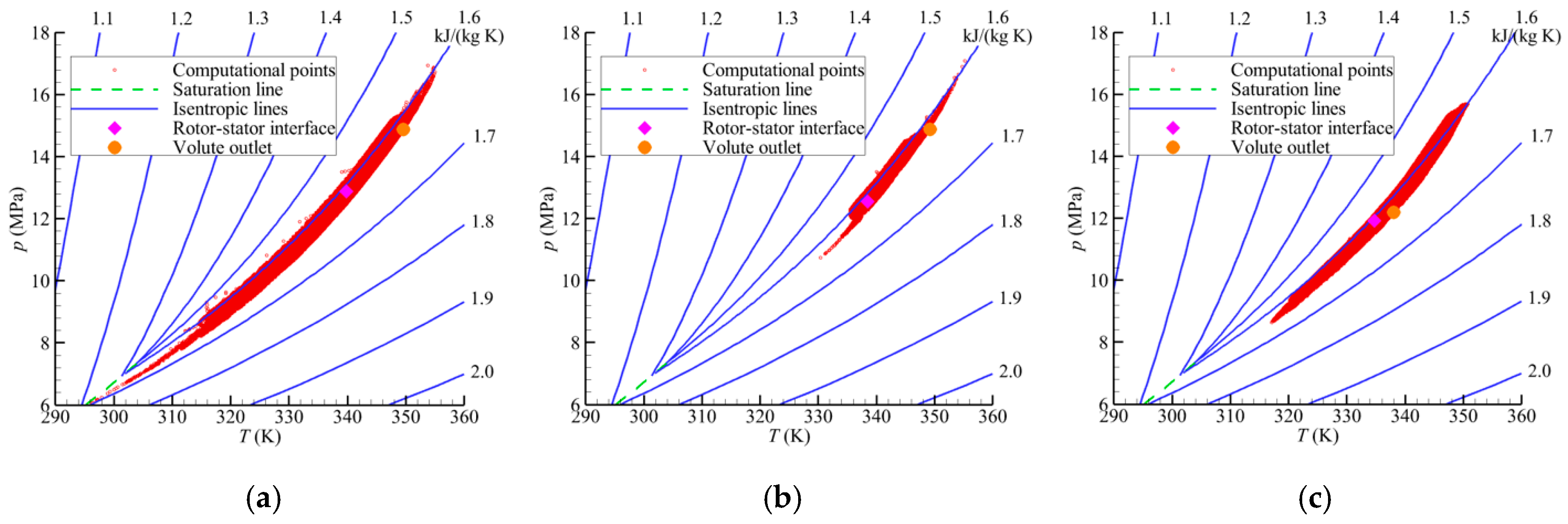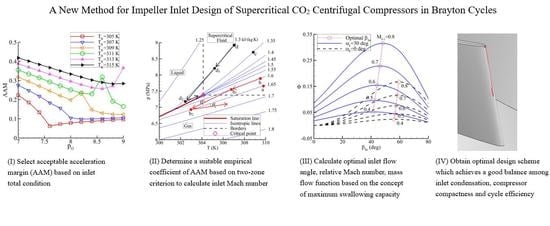In order to prevent the inlet condensation and keep the compressor geometrical compactness but remain the high cycle efficiency, a new method of designing impeller inlet is proposed for SCO2 compressors. This method is made up of the maximum swallowing capacity concept of real gas and a new condensation design principle.
3.1. Maximum Swallowing Capacity
In centrifugal compressor, the mass flow function
is usually used to assess the flow capacity of an impeller [
32], and it is defined as
The equation of continuity at the impeller inlet is written as
Using the definition of the impeller inlet shape factor
, the impeller inlet area
is
For constant angular velocity, the diameter ratio equals the blade speed ratio as
Substituting Equations (4)–(6) into Equation (3) yields
From the impeller inlet velocity triangle (see
Figure 5), we obtain
Substituting Equation (8) into Equation (7) yields
The above equations are derived based on the fundamental theories of turbomachinery, and they are independent of fluid properties.
For Equation (9), the remaining task is to crystallize and . In the case of a perfect gas, it is easy to give their specific equations based on aerodynamic correlations. However, for a real gas case especially near the critical point, these equations would be much more complicated.
According to the reference [
33], the relations between the static parameters and total ones for a real gas case are written as
where
is the isentropic exponent. It can be derived from the fundamental equations of thermodynamics as
where the specific heat ratio
and the isothermal compressibility
are
It is clear from Equation (11) that in the case of the real gas, the isentropic exponent is no longer equal to the specific heat ratio . The also involves the isothermal compressibility in addition to the , which is significantly different from the perfect gas.
Note that in the derivation of Equation (10), it assumes that the isentropic exponent remains constant from the total to static conditions (). This assumption is reasonable when the fluid state (both total and static) is not close to the critical point. In this case, the variations in are small enough such that an average value between the total and static conditions can be used.
The speed of sound for the real gas under the static and total conditions can be respectively written as
Substituting Equation (10) into Equation (13) yields
Concretely, substituting the impeller inlet parameters into Equations (10) and (14), and replacing the absolute Mach number by the relative one using Equation (8) yields
where
is an average value between the total and static conditions of the impeller inlet. It reads
Substituting Equation (15) into Equation (9) yields
It is clear from Equation (17) that the mass flow function can be generally expressed as the function of the non-dimensional parameters such as , , , and .
Eliminating the machine Mach number
in Equation (17) yields the modified mass flow function
as
Equation (18) contains four parameters (, , , and ), but only and are independent variables. The prewhirl angle is usually specified as a constant. Additionally, the inlet total condition is often given at the preliminary design phase for a compressor, leading to a determined value of . Therefore, from Equation (18) it is possible to achieve the maximum swallowing capacity (maximum ) of the SCO2 compressor under a certain inlet velocity (specified ).
In Equation (18), letting
. This yields the criterion of the maximum swallowing capacity as
Equation (19) is expressed in an implicit form, and the iteration method is used to solve this criterion.
If the prewhirl angle
is zero (axial inlet), the Equations (17)–(19) are simplified to be
The modified mass flow function
is plotted over
for a series of
at two different values of prewhirl angle (
and
) in
Figure 6. It shows that for a given
, there exists an optimal
leading to the maximum swallowing capacity (maximum
). In other words, for a specified flow capacity (given
), there is a certain
corresponding to the minimum
. It is widely recognized that reducing
is one of the most important design objectives for high speed compressors since it can minimize the passage aerodynamic losses and improve the isentropic efficiency. On the other hand,
is related to the fluid acceleration at impeller inlet. Thus, restricting
may help limit the condensation near the impeller inducer, which is a special design criterion for SCO
2 compressors.
Therefore, the maximum swallowing capacity concept for impeller inlet design has the potential to balance the inlet condensation and compressor compactness while maintain the cycle efficiency. At the preliminary design phase, the parameters , , and can be usually predefined based on the design specification, and the variables , , and are expected to be determined. However, there are only two independent Equations (17) and (19) for the above three unknown variables, for which an additional equation should be supplemented. As a matter of fact, the condensation design principle in the next subsection tends to provide this equation.
3.2. Condensation Design Principle
Though the total condition at the impeller inlet is located in the supercritical region, the flow acceleration at the impeller inducer may cause the local static properties of the fluid to enter the two-phase region (reach or cross the saturation line). As a result, the aerodynamic losses will increase since the two-phase fluid will break the original flow structures. Meanwhile, the flow becomes unstable due to the sharp discontinuity of the fluid properties near the saturation line. The term “condensation” in this study is not limited to represent the change of the physical state of a fluid from the gas phase into the liquid phase. This term is generalized to deal with the fluid reaching or crossing the saturation line (including the condensation and vaporization), which will be further explained in
Figure 7.
In order to limit the condensation near the impeller inlet, an effective and objective indicator should be firstly defined to estimate the probability of entering the condensation. The inlet absolute Mach number
represents the degree of the fluid expansion from the total to static conditions (the first acceleration). This parameter is selected as the indicator of potential condensation. Further,
is linked to the inlet relative Mach number
as follows
Equation (23) is actually the third independent equation for the impeller inlet design in addition to Equations (17) and (19). Therefore, if we can determine a reasonable value of
, it is possible to limit the inlet condensation and achieve a compact compressor design simultaneously. Here, it is assumed that
is the function of the impeller inlet total condition as
The remaining task is to determine the specific form of the function in Equation (24).
Now, we consider the expansion process at the impeller inlet. As shown in
Figure 7, the red thick line is the saturation line, and the blue lines are the isentropic lines, for which the clockwise direction indicates increasing entropy. The pink hollow circle is the critical point. The whole region is divided into three parts: gas, liquid, and supercritical fluid.
Taking point as an example: point represents the total condition, point is the corresponding static state. At the impeller inlet, point reaches point through the isentropic expansion along the isentropic line (the first acceleration), and the red arrow shows the changing direction. Then, due to the contraction of the impeller inducer area and the curvature of the blade leading edge, the flow will further accelerate from point to point (the second acceleration). This expansion process is nearly adiabatic rather than isentropic. Therefore, the changing direction deviates from the isentropic line and points to a region with larger entropy, and the deviation angle . Finally, as the fluid flows through the impeller passage, both pressure and temperature increase along the passage. The entropy of this process rises, and the corresponding deviation angle .
Point shows a similar process as point illustrated above. However, the results of the two cases are completely different. From point to point , and further to a downstream point, the fluid moves away from the saturation line. In contrast, from point to point , and further to a downstream point, the fluid gets close to the saturation line. The moving trends indicate that point is more likely stuck in the two-phase region than point .
Therefore, the supercritical inlet total conditions for the SCO
2 compressor should be split into two zones: Zone I and Zone II. Zone I contains the points
and
, which expand isentropically to the saturation line through the gas region, whereas Zone II comprises the points
and
, which go through the liquid region. The two types of inlet total conditions have the opposite directions to cross the saturation line and then enter the two-phase region (Zone I for condensation and Zone II for vaporization). Hence, different measures should be taken to limit two-phase flow for the two cases. Note that there is not phase change when the fluid crosses the border lines (dashed lines in
Figure 7), since the isolines of thermodynamic properties (like isobar and isentropic lines) are continuous from supercritical fluid to gas or liquid.
Here, a simple procedure is proposed to judge the type of a specific inlet total condition () as follows:
Procedure I
(1) Obtain the total entropy according to Equation (1); from the total to static condition through the isentropic expansion, the static entropy equals the total one .
(2) Assume that it reaches the critical temperature through the isentropic expansion, then the corresponding reference pressure is .
(3) Compare the reference pressure and the critical pressure , if , the point is in Zone II, otherwise, the point belongs to Zone I.
Supposing that the fluid does not enter the two-phase region, the maximum degree of the isentropic expansion is to reach the saturation line. The maximum achievable Mach number in this expansion process, called MAM (maximum acceleration margin), is used to represent the degree of the expansion. In essence, MAM can be considered as an equivalent distance between the inlet total condition and the saturation line. Obviously, the impeller inlet absolute Mach number is smaller than MAM.
Here, an algorithm is given to obtain MAM for a specified inlet total condition (), and the procedure is:
Procedure II
(1) Obtain the total entropy according to Equation (1); from the total condition to the saturation line through the isentropic expansion, the static entropy equals the total one .
(2) Use Procedure I to judge the type of the total condition, if it is in Zone I, ; Otherwise, .
(3) Set an initial temperature range , the recommended values for and are 216.6 K and 304.13 K, respectively.
(4) Guess the value of temperature .
(5) Calculate corresponding values of entropy , .
(6) Check the error between and , if it meets the minimum error criterion, then , go to the next step; otherwise, update the temperature range by the following rule:
{if , then , else }, and go back to step (4).
(7) Calculate the total enthalpy , the static enthalpy , the speed of sound , the fluid velocity , and the Mach number . Here is the MAM corresponding to the given total condition.
Based on Procedure II, MAM versus the impeller inlet total condition is plotted in
Figure 8a. As shown in the figure, a severe nonlinear relationship between MAM and the total pressure under certain temperature is observed. The inflection points of those isotherms appear at higher pressure regions when the temperature increases. The value of MAM should be as high as possible in order to avoid two-phase flow at the impeller throat. At the same time, however, the cycle efficiency is reduced since the impeller inlet total condition is now far away from the critical point. According to the correlation between the cycle efficiency and the inlet total condition [
18],
seems to be an acceptable range to balance the performance and condensation. In fact, MAM provides an alternative criterion to select the suitable inlet total condition, while it cannot be directly applied to the impeller inlet design with specified total condition.
Here, a more practical criterion for impeller inlet design is proposed: AAM (acceptable acceleration margin), which is an acceptable Mach number to limit condensation at impeller throat. AAM is defined as
For a given inlet total condition, MAM is uniquely determined by procedure II, the remaining task is to find the empirical coefficient .
As illustrated in
Figure 7, the flow near impeller leading edge will be further accelerated (the second acceleration) in addition to the acceleration from total to static condition (the first acceleration). According to the area ratio of throat-to-inlet, and local curvature of the blade leading edge, this second acceleration is about 2 times compared to the first acceleration. Assuming that after further acceleration, the fluid just reaches the saturation line, then the local Mach number equals
. Thus,
should be 0.5 times of
(
). As analyzed in
Figure 7, the condensation is more likely to take place for Zone II than Zone I. Therefore, a more conservative value of
is selected for Zone II. The following expression is recommended for
as
The AAM versus impeller inlet total condition is plotted in
Figure 8b, and the patterns of isotherms in the figure are similar to
Figure 8a. By checking
Figure 8b, we can quickly obtain AAM for a certain inlet condition.
In order to limit condensation, the impeller inlet absolute Mach number
should meet the criterion as
In design practice, is selected based on the above equation.
At this point, all equations for impeller inlet design have been derived. By combining Equations (17), (19), (23) and (27), the key parameters such as , , and are determined, which are able to limit the impeller condensation and achieve a compact compressor while maintain a high cycle efficiency.
To validate the condensation design principle, a method is proposed to detected fluid condensation based on the impeller inlet total condition () and the local flow parameters (). For the detection of a certain point, the procedure is:
Procedure III
(1) Use Procedure I to judge the type of the impeller inlet total condition, if it is in Zone I, ; Otherwise, .
(2) Assume that the local flow parameters are known. If , then the point is not in condensation, stop the procedure; otherwise, go next.
(3) Get reference pressure and reference density .
(4) If or , then the point is in condensation; otherwise, the point is not in condensation; stop the procedure.
Note that Procedure III assumes that condensation occurs suddenly as soon as the fluid reaches the saturation line, and this process has no delay. The heterogeneous nucleation on the passage wall and the homogeneous nucleation into the stream bulk are ignored.
